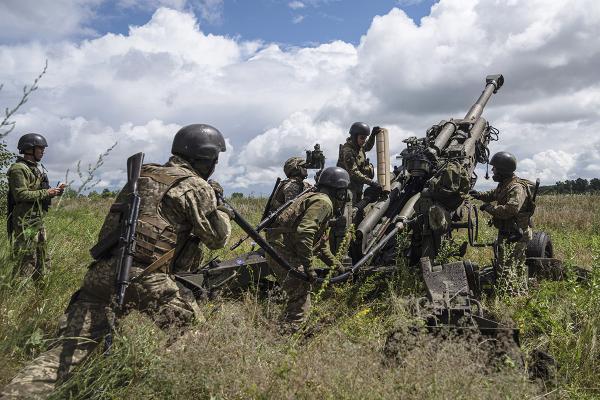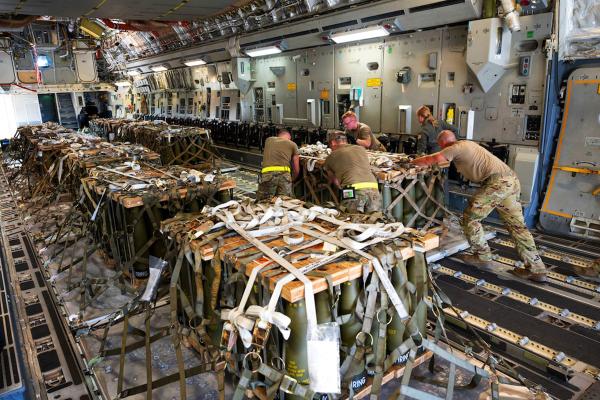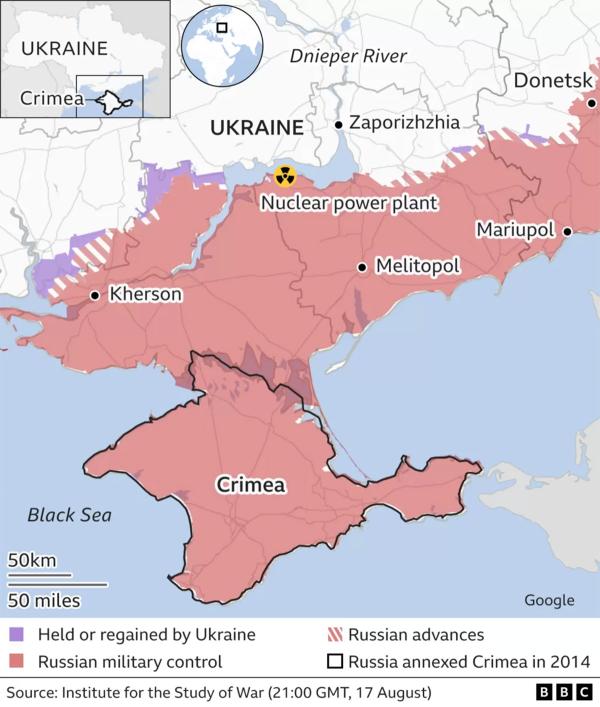
Ukrainian servicemen firing a U.S.-supplied M777 howitzer in Kharkiv region, July 14, 2022. Photo: AP
The war in Ukraine has killed at least many tens of thousands of people, driven millions from their homes, and is threatening (by choking off exports of wheat from Ukraine) what the United Nations warns is an “unprecedented wave of global hunger and destitution.” This is a proxy war between the U.S., which is funding and arming Ukraine for its own interests, and Russia, which invaded Ukraine.1 The rulers of this country say Russia’s motive in this war is driven by aspirations to be a dominant, oppressive empire. That’s true. But the reality is that no force on Earth can touch the crimes this country has committed to enforce its position atop a world of exploitation and oppression.
As hellish as the proxy war has been, there is an ominous and unpredictable trajectory in effect that has the potential to escalate explosively, into a direct war between the U.S. and Russia, and even a real danger of a nuclear war.
Alarming Developments

USAF load rounds of artillery ammunition (used in battlefield cannons) to be shipped to Ukraine. Photo: USAF
Since January 2021, the United States has committed more than $13.5 billion in military “aid” to Ukraine, including most recently $3 billion in late August for additional National Advanced Surface-to-Air Missile Systems; hundreds of rounds of artillery ammunition (used in battlefield cannons); high-tech drones; and laser-guided rocket systems.
The U.S. continues to escalate pumping advanced weapons into Ukraine including High Mobility Artillery Rocket Systems (HIMARS) that hit targets over 50 miles away with 2-3 meters accuracy. Moreover, HIMARS can be equipped with cluster munitions, which upon impact spread hundreds of bomblets over a very wide area, often causing massive civilian damage. And it gives the Ukrainian military the ability to strike deeply into Russian-held territory, and even potentially across the 1,500-mile Russia-Ukraine border into Russia itself, something that could lead to a massive escalation of the proxy war on both sides.

The U.S. is sending Ukraine High Mobility Artillery Rocket Systems (HIMARS) that hit targets over 50 miles away with 2-3 meters accuracy. Photo: General Staff of the Armed Forces of Ukraine / Estado Mayor General de las Fuerzas Armadas de Ucrania
Other recent alarming developments include Ukrainian attacks deep inside Russian-held territory; fighting that endangers Europe’s largest nuclear power plant; and the assassination of the daughter of a very prominent advisor to Russian President Putin on the outskirts of Moscow.
Ukrainian Attack on Crimea

Map dated August 2022.
According to many authoritative reports, in early August Ukrainian forces, who are getting very high-level “intelligence” and military and surveillance technology from the U.S., set off massive explosions at a weapons depot in Crimea that resulted not only in military losses but destruction of civilian infrastructure, including residential areas. As background: in 2014 Russia occupied and annexed the Crimea region of Ukraine in response to a series of moves by the U.S. that resulted in the removal of a Russia-leaning elected president and his replacement by a pro-U.S. government and the prospect of Ukraine joining the U.S.-dominated NATO military alliance, further encircling Russia.
Since 2014, Russia has considered Crimea part of Russia. A Russian diplomat recently declared Ukraine would face “Judgment Day” if it attacked Crimea. In that light, the attacks represented coming to the edge of or crossing the line of Ukraine (and the U.S.) bringing the war into Russia and creating greater urgency and basis for Russia to escalate the war in one form or another.
Both Sides Playing Nuclear Chicken with Europe’s Largest Nuclear Plant
Fighting near the Russian-occupied Zaporizhzhia nuclear plant, Europe’s largest, has endangered the power and cooling systems required to maintain the safety of the plant. The head of the International Atomic Energy Agency is warning the situation is “completely out of control” and that “every principle of nuclear safety has been violated” at the plant.
Analysis from the environmental group Greenpeace is that “In a worst-case scenario, where explosions destroy the reactor containment and cooling systems, the potential release of radioactivity from both the reactor core and the spent fuel pool into the atmosphere could create … areas of land hundreds of kilometres from the reactor site potentially becoming inhospitable for decades.” Both sides blame each other for endangering the nuclear power plant, and each side is maneuvering to advance their political and military objectives through contention over whether and how to allow international agencies to inspect the site.
The Assassination of the Daughter of Putin’s Close Advisor
On August 21, a remotely detonated car bomb blew up the SUV driven by Darya Dugina on the outskirts of Moscow, ripping the vehicle apart and killing her. Darya Dugina was a prominent news commentator in her own right, and her father, Alexander Dugin, is a hard-core nationalist, a military “hawk,” and very close spiritual, political and ideological advisor to Russian President Putin. It has been widely reported that Alexander Dugan himself was the intended target of the car bomb.
Whether this assassination was a move by Ukraine or allied forces to hit at Russia, staged by forces in Russia who are reported to be pushing Putin to take a more aggressive tack in Ukraine, or came from another quarter, the assassination is a major provocation. It triggered calls from Russian nationalists to escalate the war on Ukraine. And a member of Russia’s negotiating team with Ukraine said “it would be hard to engage in talks” for a negotiated end to the war as a result of the killing.
The car bombing and its aftermath have also increased the danger of a direct military conflict between the U.S. and Russia. Russian authorities say a Ukrainian national carried out the assassination, and Russian media reported that she fled to neighboring Estonia, a small NATO-member country bordering Russia. 2 Powerful voices in Russia are threatening that if the suspect is not handed over to Russia by Estonia, there is “every reason for the Russian Federation to take tough actions against the Estonian state.” Estonia’s foreign minister dismissed this demand, saying, “We regard this [demand to turn over the suspect] as one instance of provocation in a very long line of provocations by the Russian Federation, and we have nothing more to say about it.” Since the U.S. is formally committed to respond to any attack on a NATO country, Russian military action against Estonia could spread war to another part of Europe and greatly increase the danger of direct U.S. military involvement and a direct clash between nuclear-armed powers.

The Dangers… and the Interests of Humanity
Underlying the danger that any of these developments, or other unexpected developments, might trigger an extreme escalation of the war is the very high stakes both the U.S. and their NATO “allies” on the one hand, and Russia on the other, have invested in this war, and compulsion on both sides to break the existing, grinding stalemate to achieve their objectives.
As an indication of how potentially explosive this situation is, in an interview in the Wall Street Journal, former Secretary of State Henry Kissinger—the infamous architect of the U.S. carpet bombing of Cambodia, the fascist coup in Chile and other notorious crimes of the U.S. empire—warned, “We are at the edge of war with Russia and China on issues which we partly created, without any concept of how this is going to end or what it’s supposed to lead to.”
In an August 17 piece in Foreign Affairs (a journal that counsels the rulers of the U.S. on how to respond to political, diplomatic and military challenges) titled Playing With Fire in Ukraine: The Underappreciated Risks of Catastrophic Escalation, political scientist and international relations theorist John J. Mearsheimer warns:
Since the war began, both Moscow and Washington have raised their ambitions significantly, and both are now deeply committed to winning the war and achieving formidable political aims. As a result, each side has powerful incentives to find ways to prevail and, more important, to avoid losing. In practice, this means that the United States might join the fighting either if it is desperate to win or to prevent Ukraine from losing, while Russia might use nuclear weapons if it is desperate to win or faces imminent defeat, which would be likely if U.S. forces were drawn into the fighting.
And Mearsheimer poses this dire assessment:
This perilous situation creates a powerful incentive to find a diplomatic solution to the war. Regrettably, however, there is no political settlement in sight, as both sides are firmly committed to war aims that make compromise almost impossible. (Emphasis added in both quotes).
It is true that there is no positive outcome from this war, and many possibilities for a terrible outcome, if things remain within the realm of people choosing one side or the other. But that is not the only thing people can do! Very early in this war, the revolutionary leader Bob Avakian (BA) posed the following challenge to those who refuse to become a shameful, mindless cheering section (or cheerleaders) for the U.S. empire. That challenge is all the more crucial at this perilous moment:
What is called for, and urgently now, is to oppose all imperialist marauders and mass murderers, and all systems and relations of oppression and exploitation, while giving particular emphasis to opposing “our own” imperialist oppressors who commit their monstrous crimes “in our name” and seek to rally us to support them on the basis of a grotesque American chauvinism, which we must firmly reject and fiercely struggle against.
Essential Reading on Ukraine, by Bob Avakian
WORLD WAR 3 AND DANGEROUS IDIOCY
“LEGIT GANGSTERS”— GANGSTERS WITH NUCLEAR WEAPONS
UKRAINE: WORLD WAR 3 IS THE REAL DANGER, NOT A REPEAT OF WORLD WAR 2